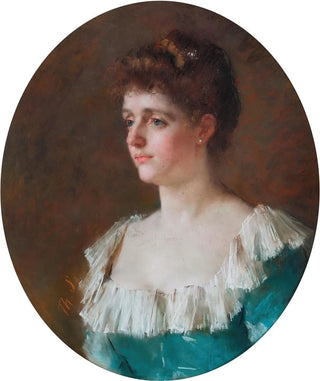Art print | Maria Cornelia Schimmelpenninck van der Oye 1857-1891 - Thérèse Schwartze


View from behind

Frame (optional)
Art print Maria Cornelia Schimmelpenninck van der Oye 1857-1891 - Thérèse Schwartze – Engaging introduction
In the vast panorama of art history, certain works stand out for their ability to capture the very essence of humanity. The art print Maria Cornelia Schimmelpenninck van der Oye 1857-1891 - Thérèse Schwartze is a perfect example. Painted by the artist Thérèse Schwartze, this iconic piece evokes not only a specific era but also a fascinating personality. Through this portrait, the viewer is invited to delve into the intimacy of a woman whose story is intimately linked to her time. Every brushstroke seems to whisper secrets, aspirations, and dreams, making this piece not only an artistic testimony but also a reflection of a rich and complex life.
Style and uniqueness of the work
Thérèse Schwartze's style is characterized by delicacy and sensitivity that transcend the simple portrait. In this piece, she manages to create an intimate atmosphere, where light plays a crucial role, illuminating Maria Cornelia's face with an almost divine softness. The chosen hues, ranging from subtle pastels to more vivid colors, evoke a rich emotional palette capable of conveying deep feelings. The composition is carefully crafted, with each element in its place to serve the visual narrative. This portrait does not merely depict a woman; it tells a story, that of a time when women began to claim their place in society. Maria Cornelia's posture, both confident and delicate, reflects an inner strength that invites contemplation and reflection.
The artist and her influence
Thérèse Schwartze, an emblematic figure of 19th-century Dutch painting, established herself in an artistic environment often dominated by men. Her training and career demonstrate a determination to make her voice heard through art. Influenced by the great masters of her time, she developed a unique style that is her own, blending realism and impressionism. Schwartze also played a crucial role in the representation of women in art, capturing their essence with

Matte finish

View from behind

Frame (optional)
Art print Maria Cornelia Schimmelpenninck van der Oye 1857-1891 - Thérèse Schwartze – Engaging introduction
In the vast panorama of art history, certain works stand out for their ability to capture the very essence of humanity. The art print Maria Cornelia Schimmelpenninck van der Oye 1857-1891 - Thérèse Schwartze is a perfect example. Painted by the artist Thérèse Schwartze, this iconic piece evokes not only a specific era but also a fascinating personality. Through this portrait, the viewer is invited to delve into the intimacy of a woman whose story is intimately linked to her time. Every brushstroke seems to whisper secrets, aspirations, and dreams, making this piece not only an artistic testimony but also a reflection of a rich and complex life.
Style and uniqueness of the work
Thérèse Schwartze's style is characterized by delicacy and sensitivity that transcend the simple portrait. In this piece, she manages to create an intimate atmosphere, where light plays a crucial role, illuminating Maria Cornelia's face with an almost divine softness. The chosen hues, ranging from subtle pastels to more vivid colors, evoke a rich emotional palette capable of conveying deep feelings. The composition is carefully crafted, with each element in its place to serve the visual narrative. This portrait does not merely depict a woman; it tells a story, that of a time when women began to claim their place in society. Maria Cornelia's posture, both confident and delicate, reflects an inner strength that invites contemplation and reflection.
The artist and her influence
Thérèse Schwartze, an emblematic figure of 19th-century Dutch painting, established herself in an artistic environment often dominated by men. Her training and career demonstrate a determination to make her voice heard through art. Influenced by the great masters of her time, she developed a unique style that is her own, blending realism and impressionism. Schwartze also played a crucial role in the representation of women in art, capturing their essence with






